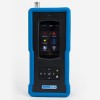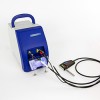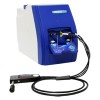
Food & Feed
In recent years, there has been a dramatic increase in the need for analysis of food quality and safety, as well as composition and authenticity of food
products; all of which can be done nondestructively with Raman spectroscopy. A couple of examples include the presence of contaminants in food, and the
identification of food additives and ingredients including cellulose, sorbitol, stearic acid and starch. The composition of edible oils and the amount of
fatty acids present in those oils is an important indication of their value as well as identity. Raman spectroscopy provides a means of quantifying the composition of fatty acids in food
products, as well as other components in food, such as flavors.
The nutritional composition of feed including quantitation of protein in grain and fat in milk can be determined using Raman spectroscopy:
• Measuring chain length and extent of saturation of fatty acids in edible oils
• Meat product quality analysis
• Product authentication and contamination
• SERS analysis of food contaminants including bacteria, antibiotics, dyes, etc.
• Analysis of components in grain kernels
• Raw material identification/verification for the food and beverage industries



